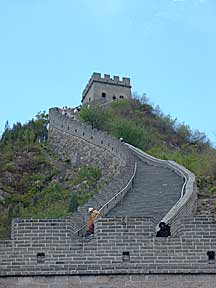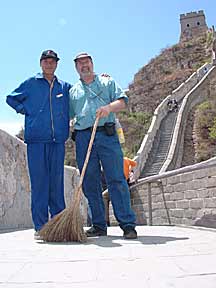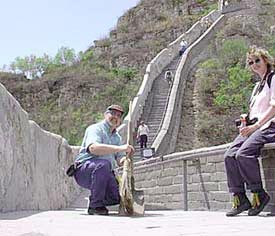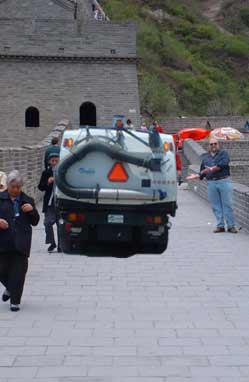Sweeping in China

Sweeping in China |
 |
China's Great Wall: World's Biggest Sweeping Opportunity?by Ranger Kidwell-RossAlthough it's a bit of a stretch to call the following a true sweeping story, there were workers on the Great Wall keeping it clean...After we had traveled perhaps 30-miles from Beijing, the terrain began to change. We had been traveling through flatlands, but now we started up through a more mountainous area. The part of the Wall where we were headed, Yu, our interpreter, told us, was one of the most important in the entire 6,700 kilometers the wall stretches. Although the entirety of the Great Wall was completed in 220 BC, this particular section, because of its proximity to Mongolia (remember from your world history classes: "The Mongol hordes swept down from the North..."), was put into place by 700 BC. That's because, not only was Mongolia directly on the other side from the part of the Wall where we'd be visiting, but this particular area contained one of the only easily traversed passes through the mountains. 
At this point, we could see the outline of the Wall becoming visible in the distance. As we drew closer, we could see there were actually two walls, separated by about 200 feet. Two Walls provided even more security against invaders coming through the mountain pass, said Yu. An advancing army would have the twin difficulty of breaching Wall #1, only to be then trapped in front of Wall #2. On each, of course, would be the defending Chinese army. We pulled into the parking area at a spot where tourists could walk along either of the Wall sections. Both were extremely steep as they clung to the mountainside. With the temperature in, I would estimate, the mid-80s, choosing to climb up to one of the distant parapets was warm business. Before taking off, I invested 4 Yuan (about 40 cents U.S.) in a bottle of water. At the same stand, a number of other curios were being sold, and the vendors were tying the packages together with poly cord. Realizing I'd have to carry the bottle up the steep incline in my hands, I motioned a request to cut me off a piece of the string. Although the young lady behind the counter understood, she couldn't think of why I'd want it and tapped on the shoulder of another employee to get her attention. Because I was sticking out like, well, a Caucasion in China by this time, all action at the counter suddenly stopped, everyone watching to see what this particular Gweilo might be up to. Determined to be helpful, what appeared to be the woman in charge grabbed some scissors and I motioned where to cut. Then, I quickly fashioned a loop on one end, passed the string through to make a slip knot, and fastened it around the top of the bottle. By now, everyone within view was watching. Passing the other end of the string over my shoulder, I tied a slip-knot that would allow the bottle to dangle when not in use, yet hang securely over my shoulder for the climb. At this, a collective "Ahhh" went up from all those watching, along with sudden smiles of understanding. One man nearby tapped his temple in a universal language. As for myself, I felt I had brought a little touch of Yankee ingenuity to China. My climb to the first parapet was a grueling 348 steps up a very steep incline; it seemed even harder coming back down. As you can see in the photos, the covered sentry houses were spaced, in this area at least, about one every 100 yards. In each of these thick block buildings is an entry and exit door, plus a window facing each of the other two directions. No one would have a chance of sneaking up on the Wall as long as these vantage points were manned by sentries. Then, once at the base, an invader's next challenge would be to scale the 30 meters of sheer surface to the top. 
Just beyond the sentry house I discovered -- you guessed it -- a sweeper! On duty to keep the wall tidy for visitors, this was a man who had an interesting commute to work. Using hand motions and smiles, I asked if I might borrow his broom and flat-bladed shovel, which he used for a dustpan, and have my picture taken. With a returned smile, he handed them over. Then, for good measure, I asked the cameraman I'd recruited to take another shot of the sweeping employee and I together. Who knows what they thought this crazy tourist was up to? I'm sure they simply figured I was an American, which goes a long way toward explaining just about any kind of strange behavior, I suspect. 
I knew the rest of our party, all of whom declined to join me on my trip to the top, were no doubt waiting below for my return. I took a last look around, for a moment letting my thoughts drift back in time. The year was 200 BC, and here stood Ranger, the lone sentry between my country and a suddenly appearing invading Mongol army. The excited chattering of a young couple emerging from the guardhouse brought me back to the present. I headed back down to the waiting car below, content that this particular item could now be crossed off my life list. I had traversed a portion of the Great Wall of China, a structure that has stretched in a 1,600 mile continuous unbroken line for more than 2,000 years. 
Meanwhile, Mark Schwarze, at the time president of Schwarze Industries, Inc. and my host for this Asia trip, was no doubt dreaming about the implications of getting a 2,600 km contract to sweep the Great Wall of China... Note that to help his daydream gain some life, we took a little graphic license in adding a sweeper to the picture. In reality the job is done by hard-working Chinese citizens with hand brooms. And, we admire them greatly for it.
This story was one written during our editor's trip to Asia in 2001 to investigate sweeping. While he was there, Ranger wrote an online journal for the sweeping industry. You may still view this online journal, which won a U.S. APEX Award for Online Journalism.
|